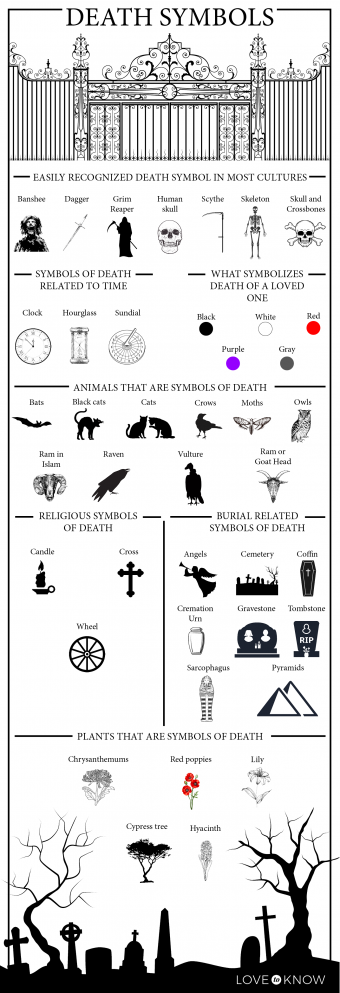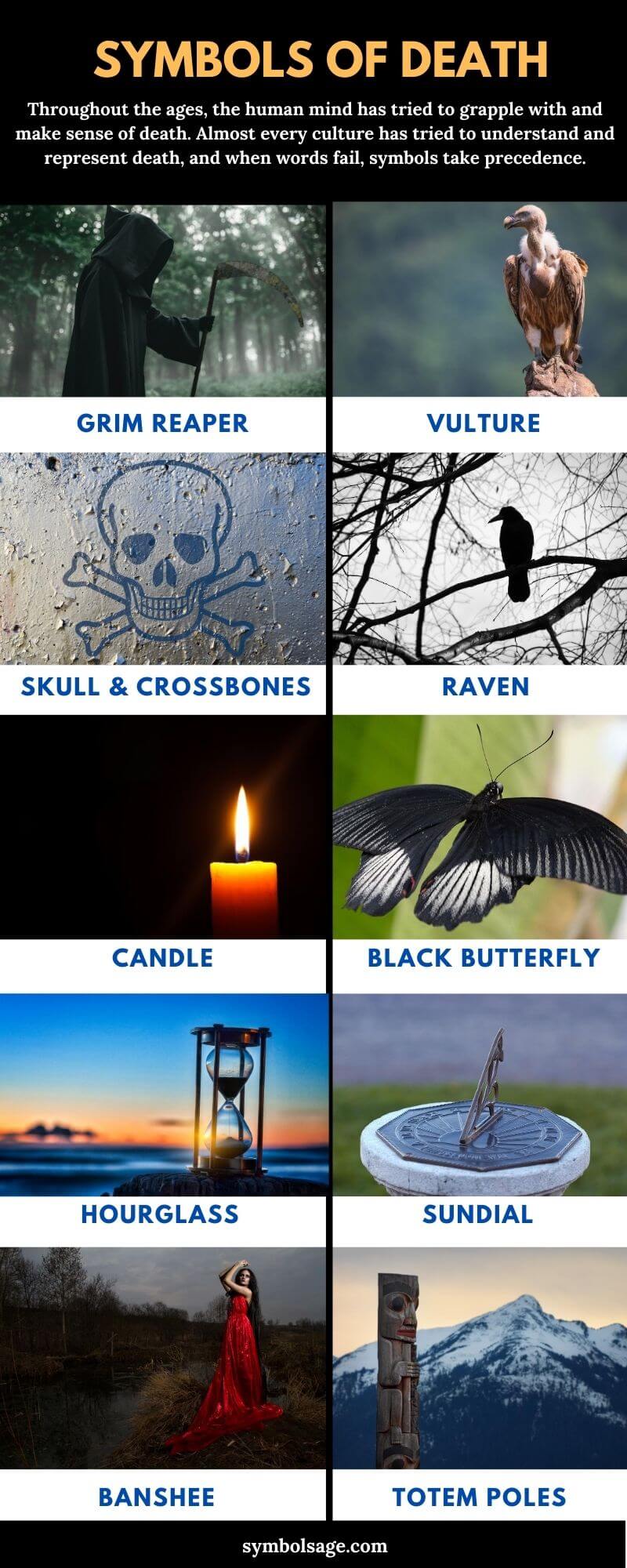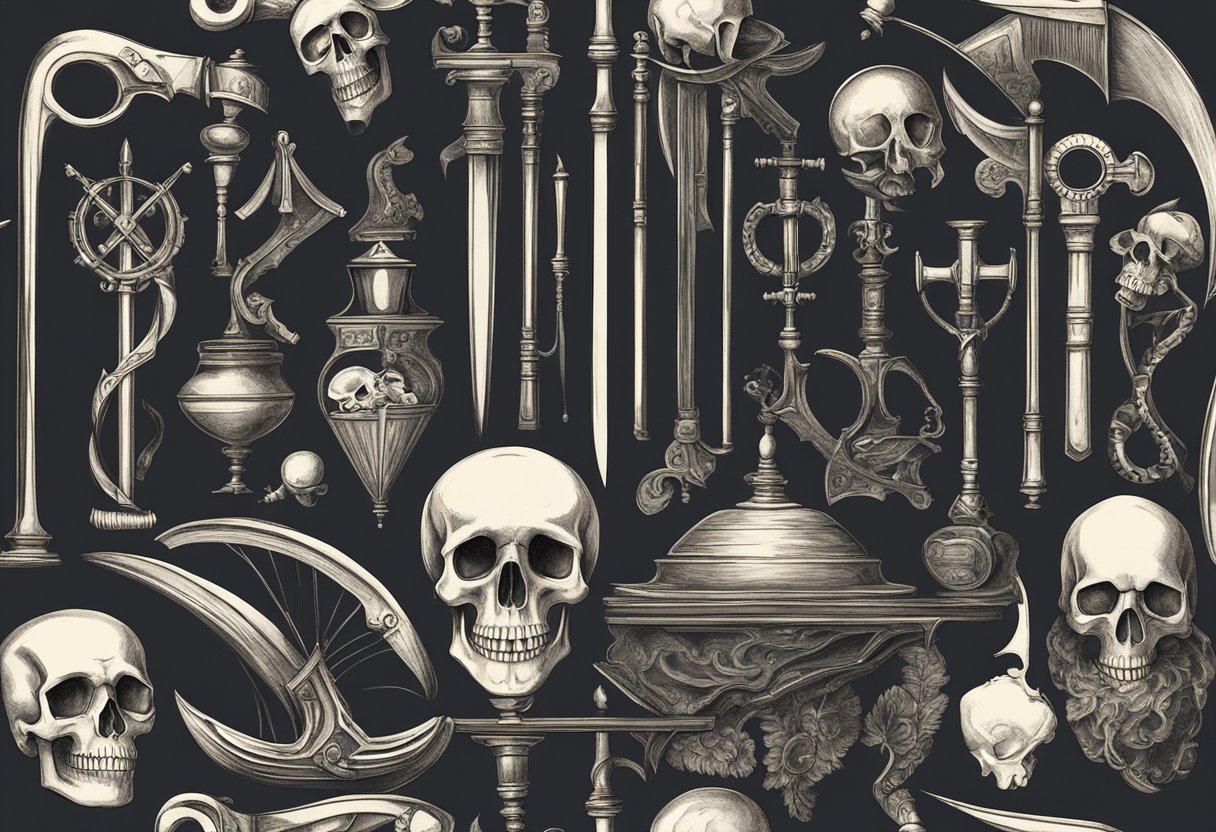Symbols Of Death: Unpacking Their Deep Meanings Today
Death, in a way, is a truth we all share, isn't it? It’s something that touches every single one of us, no matter where we live or what we believe. Because it’s such a big, powerful part of life, people have always tried to make sense of it. They’ve looked for ways to talk about it, to feel a little more comfortable with it, or just to remember those who have passed on. That's where symbols of death come into play, really.
These symbols, you know, they pop up everywhere. You might see them in old artwork, in stories passed down through generations, or even in the things people choose to wear or display today. They’re not just scary things, not always. Often, they’re about memory, about change, about the cycle of life itself. They offer a kind of language for something that can be very hard to put into words.
So, what we're going to do here is take a look at some of these common symbols of death. We’ll explore what they mean to different people and in different times, and how they help us think about life’s big questions. It’s a pretty interesting topic, actually, and it helps us see how humans have always tried to understand what comes next, or what it means when someone is gone.
Table of Contents
- Universal Symbols of Mortality
- Animals as Messengers of the End
- Plants and Flowers: Nature's Gentle Farewell
- Cultural Interpretations of Death Symbols
- Modern Takes on Old Meanings
- Frequently Asked Questions About Symbols of Death
- Beyond the Veil: Understanding Our Shared Humanity
Universal Symbols of Mortality
There are some symbols, you know, that just seem to pop up everywhere, no matter the culture or the time period. These symbols of death are almost like a shared language for something that affects us all. They speak to the very core of what it means to be alive and, well, to eventually not be.
The Skull: A Stark Reminder
The skull is probably one of the most widely recognized symbols of death, isn't it? It's pretty straightforward, actually. When you see a skull, you’re looking at what remains after life has gone. It’s a very direct reminder of our own fragile nature, and that life doesn't last forever. In art, it often means 'memento mori,' which is a Latin phrase that just means 'remember you must die.' It’s a way to encourage us to live well, because our time is limited, you know.
You’ll find skulls in old paintings, on pirate flags, and even in fashion today. While it can feel a bit spooky, it’s really just a plain, honest look at the end of things. It’s a symbol that makes you pause and think, which is kind of the point.
The Scythe: The Reaper's Tool
When you think of the Grim Reaper, you probably picture a figure holding a scythe, right? This tool, originally used for harvesting crops, became a powerful symbol of death, pretty much because it "reaps" lives just like a farmer cuts down wheat. It’s a rather chilling image, to be honest, suggesting that death comes for everyone, without fail.
The scythe, in a way, represents the finality and the unstoppable nature of death. It’s a tool that gathers, and in this context, it gathers souls. It’s a very old symbol, and it shows how people have thought about death as a kind of harvest, a natural end to a season of life.
The Hourglass: Time Slipping Away
The hourglass is a very visual way to show time passing, isn't it? As the sand trickles from the top bulb to the bottom, it's a clear picture of how our moments are running out. This makes it a pretty powerful symbol of death, reminding us that our time on earth is limited and constantly moving forward.
You often see the hourglass paired with other symbols of mortality, like skulls or wings, to really drive home the idea of fleeting existence. It’s a simple object, but it carries a very heavy meaning, prompting us to consider how we spend our precious time, you know, before the last grain of sand falls.
Animals as Messengers of the End
Animals have a special place in our stories and beliefs, and some are very often linked with symbols of death. This isn't always about fear, though. Sometimes, these creatures represent guidance, transformation, or even a connection to another world. It's quite interesting, how different cultures see them.
The Owl: A Quiet Watcher
The owl, with its silent flight and nighttime habits, has been seen as a symbol of death in some cultures, or at least a messenger of it. In ancient Greece, for instance, it was linked to Athena, the goddess of wisdom, but in other places, its hoot was sometimes thought to signal a coming end. It's a rather mysterious bird, you know, often associated with secrets and the unseen.
However, the owl is also a symbol of wisdom and knowledge. So, its connection to death can also mean a deeper understanding of life's cycles, or even a watchful presence during times of transition. It's a bit of a dual symbol, really, holding both a bit of somberness and a lot of insight.
The Raven: A Somber Companion
Ravens, with their dark feathers and clever ways, often appear as symbols of death or bad omens in many stories. Their presence on battlefields or around places of passing probably led to this connection. They are pretty smart birds, actually, and their calls can sound quite eerie, which adds to their mysterious vibe.
Yet, like the owl, the raven also has other meanings. In some Native American traditions, for example, the raven is a trickster figure, or a bringer of light and creation. So, while it can certainly represent the end, it also sometimes speaks of new beginnings or hidden knowledge, which is kind of cool.
The Butterfly: A Soul's Transformation
Unlike some of the other animal symbols, the butterfly is often a much softer, more hopeful symbol of death. Its journey from a caterpillar to a cocoon, and then finally to a beautiful winged creature, is a powerful picture of transformation. This makes it a very fitting symbol for the soul leaving the body and moving on, or perhaps even being reborn.
Many cultures see the butterfly as representing the human soul or spirit. It suggests that even though the physical body might pass, something beautiful and free continues. It’s a very comforting image for many people, showing that there might be something graceful after the end, you know.
Plants and Flowers: Nature's Gentle Farewell
Nature, with its cycles of growth and decay, gives us many symbols of death that are perhaps a bit more gentle than the skull or scythe. Flowers and trees, in particular, often stand for remembrance, peace, or the natural flow of life and its eventual conclusion. They offer a softer way to think about passing.
The Lily: Purity and Passing
The lily, especially the white lily, is a very common flower seen at funerals and is a strong symbol of death. Its pure, clean appearance often represents the innocence and purity of the departed soul. It’s a beautiful flower, and its presence can bring a sense of peace to a somber occasion.
In Christian traditions, the lily is often linked to the Virgin Mary, and it can also symbolize resurrection and a renewed spirit. So, while it certainly marks a passing, it also holds a promise of something beyond, which is very comforting for many.
The Cypress Tree: Everlasting Grief
The cypress tree, with its tall, dark, and often somber appearance, has been a symbol of death and mourning for a very long time. You often see these trees planted in cemeteries, especially in Mediterranean regions. They stand tall and green even in harsh conditions, making them a powerful image of everlasting grief or remembrance.
Its evergreen nature suggests a kind of eternal sorrow, or a lasting connection to those who have passed. It’s a very dignified and quiet symbol, sort of standing guard over the resting places of loved ones, you know.
The Poppy: Rest and Remembrance
The poppy, particularly the red poppy, has become a very strong symbol of remembrance, especially for soldiers who died in war. Its vibrant color against the fields of battle, as described in poems like "In Flanders Fields," made it a poignant reminder of lives lost. It’s a very striking flower, and its connection to sleep and peace also ties into its meaning as a symbol of death.
Beyond its military associations, the poppy can also symbolize eternal sleep or rest. Its delicate petals and the way it seems to sway gently in the breeze give it a quiet, reflective quality. It’s a flower that makes you pause and remember, which is pretty powerful.
Cultural Interpretations of Death Symbols
It's fascinating, really, how different cultures have their own unique symbols of death, each reflecting their particular beliefs about what happens after life. These symbols are deeply woven into their traditions, their art, and their daily lives. They show us how diverse human experiences with mortality can be, you know.
Ancient Egypt: Life Beyond the Veil
Ancient Egyptians had a very rich and detailed set of symbols related to death, because they believed so strongly in an afterlife. For them, death wasn't an end, but more like a transition to another form of existence. The ankh, for instance, a cross with a loop at the top, is a very famous symbol of life itself, but also of eternal life and rebirth after death. It's pretty much everywhere in their art.
Mummification practices and the elaborate tombs, like the pyramids, were also symbols in their own way, showing their dedication to preserving the body for the soul's journey. Scarab beetles, which emerged from what seemed like nothing, symbolized creation and rebirth. They were very optimistic about what came next, apparently.
Mexico's Day of the Dead: A Colorful Celebration
In Mexico, the Day of the Dead, or Día de los Muertos, is a vibrant and joyful celebration, which is quite different from how some cultures view death. Here, symbols of death are often colorful and playful. The "Calaveras," or sugar skulls, are probably the most famous. They're often decorated with bright colors and patterns, and they represent departed loved ones in a very sweet way.
Marigolds, with their bright orange and yellow petals and strong scent, are used to guide spirits back to their families. This tradition shows a deep respect and love for those who have passed, treating death not as something to fear, but as a natural part of life's cycle, where family connections remain strong. It's a beautiful approach, honestly.
Christianity: Hope and Resurrection
In Christian traditions, symbols of death often carry a strong message of hope and resurrection. The cross, obviously, is the most central symbol, representing the sacrifice and the promise of eternal life. It’s a very powerful reminder of faith and salvation. You see it everywhere, really.
Other symbols include the lamb, which can mean innocence and sacrifice, and specific flowers like lilies or chrysanthemums, which we talked about, often symbolize purity or the cycle of life and rebirth. The idea is that death is not the final chapter, but a step towards something new and everlasting, which is very comforting for believers.
East Asian Traditions: Respect and Renewal
In many East Asian cultures, symbols of death often focus on respect for ancestors, the natural cycle of life, and the idea of renewal. White clothing is traditionally worn for mourning, representing purity and the shedding of earthly ties. This is a bit different from Western cultures, where black is usually the color of mourning.
Chrysanthemums, particularly white ones, are very common at funerals in countries like Japan and Korea. They symbolize grief, lamentation, and truth. The concept of ancestors continuing to be a part of family life is also very strong, with rituals and altars dedicated to remembering and honoring those who have passed. It's about continuity, in a way.
Modern Takes on Old Meanings
It's pretty interesting how symbols of death, even very old ones, still hold meaning for us today, isn't it? Sometimes, their meanings shift a little, or they pop up in new places, like tattoos, digital art, or even video games. We might see a skull on a fashion item, or a raven in a popular movie, and they still carry a bit of that old weight, even if they’re used in a fresh way.
People are also finding new ways to remember and express grief. Online memorials, digital art, or even personalized symbols that mean something special to a family. These modern expressions show that our need to make sense of death, to remember, and to find comfort is still very much alive. We're always trying to connect with something bigger, you know, even if the methods change.
The symbols might look different, or be used in different contexts, but their core purpose remains: to help us process loss, to remind us of life's value, and to connect us to a shared human experience. It's a pretty powerful thing, how these old ideas keep finding new life.
Frequently Asked Questions About Symbols of Death
Many people have questions about these powerful symbols. Here are a few common ones, basically, that come up when folks are thinking about death and its many representations.
What are some of the most common symbols of death?
Some of the most common symbols, you know, include the skull, the scythe, and the hourglass, which all pretty clearly represent the end of life and the passage of time. Animals like ravens and owls, and flowers like lilies or poppies, are also very widely recognized for their connections to mortality. These symbols pop up in so many different places.
What flower symbolizes death or mourning?
The white lily is very often used as a symbol of death and mourning, representing purity and the soul's departure. Chrysanthemums, especially white ones, are also widely associated with grief and funerals in many East Asian cultures. Poppies can symbolize remembrance and peace, particularly in relation to war. It just depends on where you are, basically.
Do symbols of death always mean something bad?
Not at all, actually! While some symbols, like the skull, can feel a bit grim, many symbols of death also represent transformation, remembrance, or even hope for an afterlife. The butterfly, for example, shows the soul's journey, and in cultures like Mexico, death symbols are part of a joyful celebration of life and family. It’s all about context, you know.
Beyond the Veil: Understanding Our Shared Humanity
Looking at these symbols of death, you can see how people all over the world, across different times, have tried to make sense of something so big and so universal. They give us a way to talk about what's hard to talk about, to grieve, to remember, and to find some comfort. It’s a very human thing to do, to create these visual reminders of life's delicate nature.
Whether it’s an ancient Egyptian ankh or a modern tattoo, these symbols remind us that death is a part of the grand story of life. They help us connect with our past, with other cultures, and with the very deep feelings we all share when we think about endings and new beginnings. It’s a pretty powerful way to understand our shared humanity, really. Learn more about symbols and their meanings on our site, and for deeper insights into cultural practices surrounding mortality, you can also explore this page .

Ancient Symbols Of Death

Ancient Symbols Of Death

Symbols of Death: Understanding Cultural Representations - Brilliantio